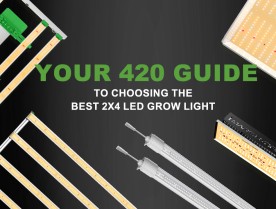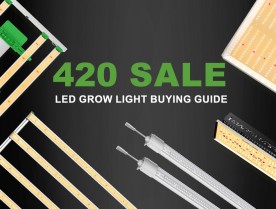
From their broader light spectrum to their lower ambient heat, LED grow lights have many attractive features for indoor plants cultivators. However, most customers convert to LED grow lights because of their lower cost — especially their energy efficiency.
Compared with traditional HPS models, LED grow lights have a reputation for being more cost-effective. But how much cheaper is it to operate Mars Hydro LED grow lights? Is there an easy way you could estimate your monthly energy costs right now?
Hold On A Second, Are LED Grow Lights Truly The Cheapest Option?
Before calculating an average LED grow light’s energy cost, you may be skeptical whether LEDs are cheaper than traditional HPS models. For people who’ve never used LED grow lights before, the advertised cost savings can seem too good to be true.
In most cases, high-quality LED grow lights cost less in the long run versus HPS lights. You'll probably pay more upfront for LEDs versus HPS, but they are the more energy-efficient option.
Most LEDs provide a PPE of 2.7 - 3.5 μmol/J, while an HPS light pulling the same wattage will only give you 1.8 μmol/J. That is to say, the demand wattage of LED is much lower than HPS with the same PPE, so it can save a lot of electricity cost. Also the cost of HVAC system is much lower than HPS because LED emits much less heat. So, you could enjoy far better light penetration with an LED grow light while pulling as much as 40 percent less energy.
Beyond saving your total energy costs, LED grow lights have additional cost-saving benefits like fewer maintenance costs and a longer lifespan. Plus, when you opt for dimmable Mars Hydro LED grow lights, you’ll have an easier time adjusting your energy costs.

What’s The Easiest Way To Calculate LED Grow Light Energy Cost?
If you want to get a solid estimate of your LED grow light’s average cost, you need three pieces of info:
- Your LED grow light’s wattage
- The total time you keep lights on
- The electricity price in your area
Once you find your LED grow light’s total wattage, you could divide by 1,000 to get the rate for kilowatts. You could then multiply these kilowatts by the number of hours you keep your LED grow lights on to get the kilowatt-hours (kWh).
For instance, if you’re using a 480W Mars Hydro FC-E 4800, you could multiply 0.48 kilowatts by 18 hours to get 8.64 kWh. You could multiply 8.64 kWh by your area’s electricity rate to get the average cost per day.
The average electricity cost in the USA is about 12.83 cents per kilowatt-hour. So, using the example above, 8.64 kWh x $0.1283 = about $1.11 per day. Multiply by 30 days to figure out the average monthly cost.
When multiplying these figures, please remember that different growth stages for plants require distinct durations. Also, every strain has a unique growing pattern which may affect how long you keep your lights on.
In general, most plants strains mature at the following rate:
- Germination 3-10 days; 18 hours of light per day
- Seedling 2-3 weeks; 18 hours of light per day
- Vegetative 3-16 weeks; 18 hours of light per day
- Flowering: 8-11 weeks; 12 hours of light per day
If you tally all these numbers up, your LED grow lights will be on for at minimum ~ 1,350 hours.
Please also consider the intensity of your Mars Hydro LED grow lights when calculating your monthly cost. Many cultivators who install Mars Hydro LED grow lights use the dimmer option for germination, seedling, and vegetation, which will reduce your total wattage.
FYI: There are many watts to kilowatt-hours calculators online if you want to check your math.

How Could You Bring Down Your LED Grow Light’s Electricity Cost?
Most plants cultivators use to save on energy is to run their lights at the least expensive times. It’s often cheaper to use electricity during “off-peak” hours late at night or early in the morning. Your electrical rates will also vary depending on the season and where you choose to set up your grow room.
It’s also essential to consider what strain you’re growing when evaluating energy cost. Full-bred sativas usually require the most time and attention to grow — hence, they demand more energy. By contrast, growing autoflower strains takes less time to reach full flowering. Autoflower plants yields less than non-ruderalis plants, but it doesn’t require as much time, care, or light penetration.
Another tip some cultivators save money simply by switching to LED grow lights, but there are many strategies you could use to bring your energy costs down. Investing an LED grow light with a built-in dimmer and high quality gives you more control over your total energy output. It’s also easier to control heat dissipation and avoid issues like bud burn with a dimmer function.

Enjoy Optimal Energy Efficiency With Mars Hydro LEDs
Although most LED grow lights have lower energy costs andincreased yields, not all manufacturers are created equally. It’s important to go with brands like Mars Hydro that use dimmable switches, full-spectrum Samsung diodes, and daisy-chain attachments to improve cost and efficiency.
Please take a few moments to calculate your daily energy needs by reviewing the details on our FC, FC-E, SP, or TS models. You could also contact Mars Hydro's staff if you have questions about how our LEDs will impact your cultivation goals.






